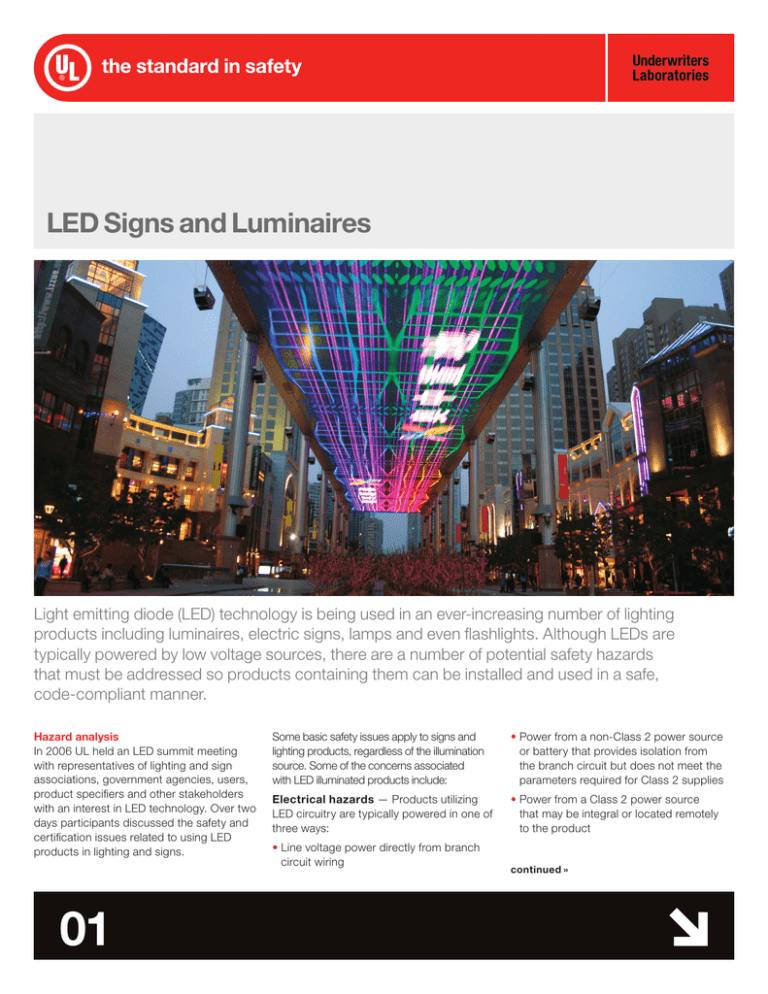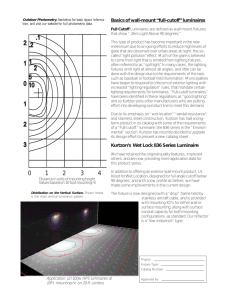LED Signs and Luminaires
advertisement

LED Signs and Luminaires Light emitting diode (LED) technology is being used in an ever-increasing number of lighting products including luminaires, electric signs, lamps and even flashlights. Although LEDs are typically powered by low voltage sources, there are a number of potential safety hazards that must be addressed so products containing them can be installed and used in a safe, code-compliant manner. Hazard analysis In 2006 UL held an LED summit meeting with representatives of lighting and sign associations, government agencies, users, product specifiers and other stakeholders with an interest in LED technology. Over two days participants discussed the safety and certification issues related to using LED products in lighting and signs. 01 Some basic safety issues apply to signs and lighting products, regardless of the illumination source. Some of the concerns associated with LED illuminated products include: •Power from a non-Class 2 power source or battery that provides isolation from the branch circuit but does not meet the parameters required for Class 2 supplies Electrical hazards — Products utilizing LED circuitry are typically powered in one of three ways: •Power from a Class 2 power source that may be integral or located remotely to the product •Line voltage power directly from branch circuit wiring continued » LED Signs and Luminaires (continued) Both line-connected and non-Class 2 powered products may pose a risk of electric shock due to the energy levels present. Low voltage products may also pose a risk of electric shock because the low voltage seen at the LEDs may be provided by in-line impedance or in some other manner that does not comply with Class 2 circuit requirements. Under certain conditions, such as open circuit, there may be voltages present that represent a risk of electric shock. Fire hazards — Although they operate at low voltage, LED illumination sources can generate considerable thermal energy that can create a potential fire hazard. Like any product utilizing an illumination source, products incorporating LED circuitry must be designed and investigated to verify that thermal energy generated by the llumination source is not transferred to polymeric or other combustible materials in a manner that creates a potential fire hazard. Other hazards — All lighting products, including those incorporating LED circuitry, must be designed and investigated to reduce the risk of personal injury during installation and use. UL requirements and standards When investigating lighting products utilizing LED circuitry, they are first evaluated using the appropriate UL Standard for Safety for the end product, such as the UL 1598 Standard for Safety for Luminaires, or the UL 48 Standard for Safety for Electric Signs. These basic product requirements are supplemented with requirements included in the Subject 8750 Outline of Investigation for Light Emitting Diode (LED) Light Sources for Use in Lighting. This outline includes construction and performance requirements specifically designed to address LED safety concerns. Product categories Signs utilizing LED technologies are covered under the product category for Signs (UXYT). Light-emitting-diode luminaires are covered under several 02 different product categories; the guide information for Light-emittingdiode Luminaires (IFAK) includes a list of these product categories. Lowvoltage lighting systems, including power units, luminaires and fittings, are covered under the Low-voltage Lighting Systems, Power Units, Luminaires and Fittings (IFDR) product category. Information on all of these product categories and the related certifications can be found in UL’s Online Certifications Directory at www.ul.com/database. National Electrical Code® requirements The 2008 National Electrical Code ® covers the installation of lighting type products and signs using LED circuitry and other illumination technologies. The code recognizes the value provided by requiring these products to be listed. Article 410 covers luminaires, lampholders, lamps, and other lighting products and accessories. Section 410.6 requires all luminaires and lampholders to be listed. Similarly, Section 600.3 requires electric signs, section signs and outline lighting to be listed and installed in conformance with that listing, unless otherwise approved by special permission. Article 411 covers lighting systems operating at 30 volts or less. Section 411.3(B) requires these systems to be listed either as a complete system or as an assembly of specifically identified listed parts. The luminaire, power supply and luminaire fitting, including the exposed bare conductors, of an exposed bare conductor lighting system must be listed for use as part of the same lighting system. Installation considerations Code authorities can expect to see an ever-increasing number of products incorporating LED technology being installed in their jurisdictions. By making sure that the products are Listed and installed in accordance with the manufacturer’s instructions and applicable NEC ® requirements, safe code-compliant installations can be achieved. Copyright © material from Issue 4, 2009, The Code Authority newsletter. This material may not reflect changes that have occurred since its original publication.

